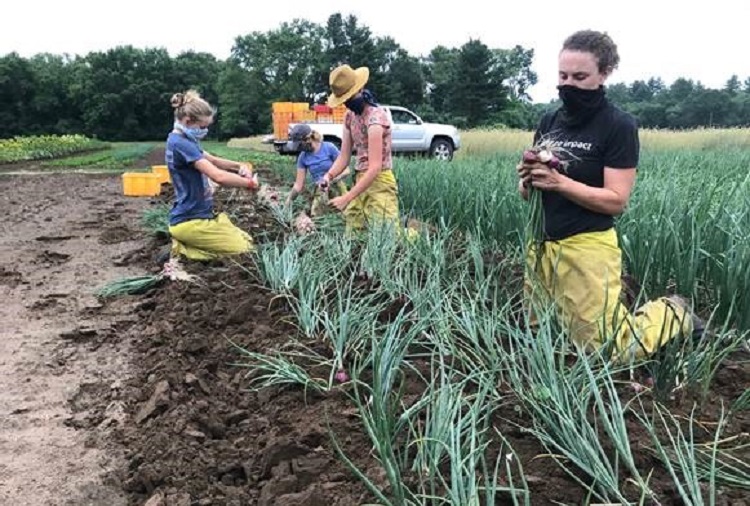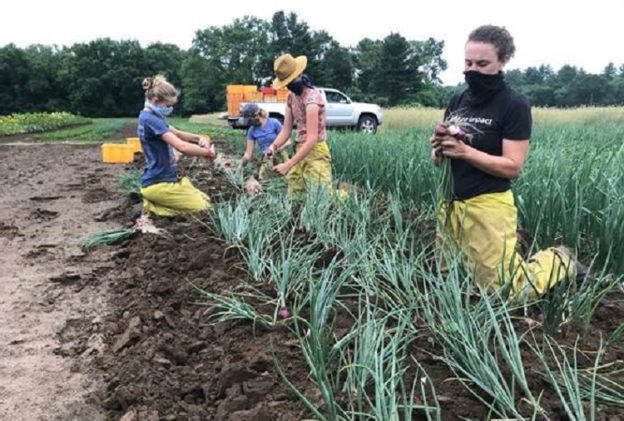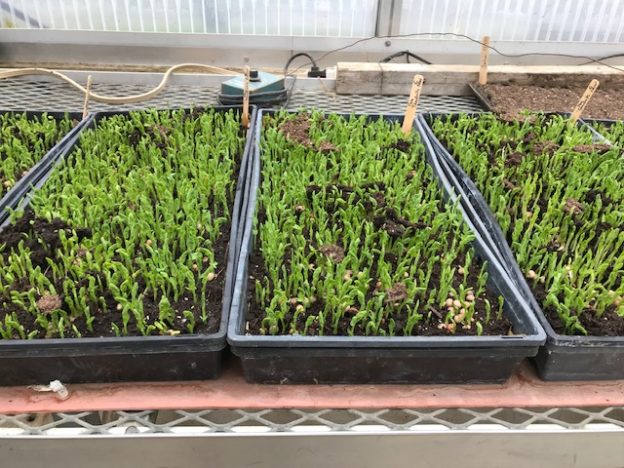We had the best kind of fireworks Sunday night—lightning, thunder, and rain! Three separate storms soaked the farm around 9 p.m., and after a very dry June, July is blessing us with plenty of water. On Sunday, wagering on nature to help us out in our no irrigation system, we seeded a half-acre of greens, carrots, beets, and beans. On Friday, with help from volunteers, we planted broccoli, lettuce, and cucumbers—over 3,000 transplants in all.
In the Scrape

Above, you can see Jill guiding the water wheel out in front of volunteers, and Margot, obscured behind the tractor “in the scrape”, as the team has taken to describing it–scraping mud from the marking spikes. It’s a challenging role because as the tractor is creeping along, there are three marking wheels with spikes spaced as closely as 6 inches apart, all of which need to be kept mud-free in order for water to flow through them and into the holes where the seedlings will go. On top of that, the flow of water to each separate wheel must be balanced by adjusting knobs on each of three hoses—open one hose too much and it reduces flow to the other two. The flow rate is also constantly affected by the amount of water in the tank, the shift in pitch of the bed, and whether the tractor is traveling up or down a slope. Never having pumped the bellows or thrown the stops on a pipe organ, with hands flying between spikes and knobs, I still think of the person “in the scrape” as Bach at the keyboard, mid-fugue.
Volunteers Needed
In addition to helping us plant all those seedlings, the Friday volunteer group also cleared weeds from our overgrown eggplant beds. We had left the Proteknet over the slow-growing eggplant since the moment of transplanting in order to exclude flea beetles and Colorado potato beetles. But we had achieved good control of beetles in the adjacent potato patch using organically certified sprays, so it was time to uncover the eggplant and get after those weeds. I’m not sure how long it would have taken us to complete the job on our own, but all those volunteers got it done in about twenty minutes!
We will need more volunteer help for some big upcoming harvest jobs including string beans, potatoes, garlic, and cherry tomatoes. We will start picking beans and digging new potatoes this week, and we usually start pulling garlic and harvesting cherry tomatoes by the third week of July.
New Potatoes & Spring Onion Bouquets
A “new potato” is the result of pulling the plant before it has fully matured. It’s like green garlic in that you’re sacrificing volume to enjoy the crop when it’s most tender and mild. The skins of new potatoes often flake off in the washing process because they haven’t fully set, and when you’re separating the tubers from the plant, you see some marble-size ones that would have become full-size. Farmers charge more for new potatoes to offset the reduction in harvest quantities.

Spring onions are the other exciting crop coming in from the field right now. They need to be eaten fresh as they don’t dry down and keep like storage varieties. Above, from L to R, Paige, Margaret, Margot, and Jen are making bunches of the spring onion variety Purplette. The soil has been loosened by the tractor passing by with the undercutting bar, and you can see their focus and attention to technique following the picking mantra we teach: “make each bunch a bouquet of flowers; make it for someone you love.”
It’s unusual not to see a single weed in a bed of onions—onions with their slender leaves don’t do a good job of taking up space and shading out competing weeds. Volunteers who had been helping us pick strawberries on Wednesdays and Fridays, rounded out their sessions by weeding in the onion patch. So helpful! Thank you.
Your Farmers





